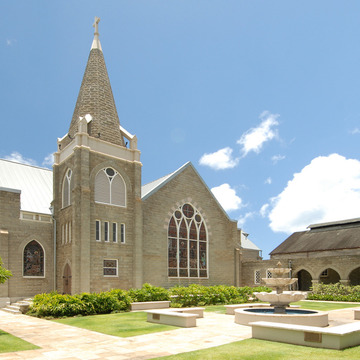Constructed of concrete block made to look like rusticated stone, this early-twentieth-century church is a good example of its period's approach to the Gothic style. It includes mock buttresses at the corners, large Gothic-arched stained glass windows with tracery, an octagonal apse, and a corner bell tower with small flying buttresses supporting the spire. The interior, with a beautiful wooden rib-vaulted ceiling, shallow transepts, and stained glass windows manufactured by E. Chausse of Le Puy, France, is particularly well appointed. This vibrant stained glass is among the finest in Honolulu. Windows illuminating the rear choir loft depict angels as musicians; a nave window includes a depiction of a stained glass window within its composition, revealing a light humor.
Edgar Allen Poe Newcomb not only practiced architecture he also wrote poetry and composed music. He came to Hawaii in 1901 with his sister after a successful architectural career in Massachusetts. He initially entered into a partnership with C. W. Dickey, which lasted until 1907, then had an independent practice in Honolulu until his death in 1923. Newcomb obtained several commissions from the Catholic Church including St. Joseph's Catholic Church (HA42) in Hilo and St. Anthony's Church (1919; demolished) on Maui.















